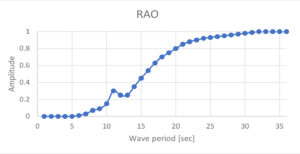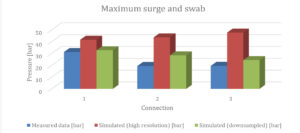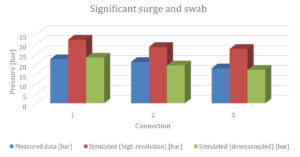Surge and swab during drill pipe connections on floaters may affect pressure windows in calm weather
Significant rig-heave induced pressure variations revealed in study of drillship offshore Brazil, highlighting need for simulation tool for harsh conditions
By John-Morten Godhavn and Banzi Olorunju, Equinor; Dmitri Gorski, Martin Kvernland and Mateus Sant’Ana, Heavelock Solutions; Ole Morten Aamo and Sigbjørn Sangesland, NTNU
During drilling and completion, the downhole pressure in a well should be kept lower than the fracture pressure and higher than both the pore pressure and wellbore collapse pressure. Falling below that lower limit pressure could lead to wellbore stability challenges and a possible undesired influx of hydrocarbons into the well, while exceeding the upper limit could cause the well to fracture, resulting in costly mud losses. All of this means an increase in nonproductive time (NPT) and higher drilling costs.
Floating rig motion caused by waves and swell (rig heave) can induce downhole pressure variations (surge and swab) when the drill string is suspended in slips – typically to make up or break a drill pipe connection – and topside heave compensation is temporarily deactivated. This is a known issue in regions with harsh weather such as the North Sea, where pressure oscillations of up to 20 bar have been reported during connections. But it can also challenge the available pressure window for wells in regions with calmer weather, such as Brazil.

Various technologies offer opportunities to manage downhole surge and swab induced by rig heave. Managed pressure drilling (MPD) is often used to drill wells with narrow pressure margins. Automatic control with the topside MPD choke can compensate and maintain a constant downhole pressure when the mud pumps are started and stopped, during tripping operations (in and out), and during running of the completion string. All of these events are controlled from topside, and control solutions can be developed, optimized and verified; for example, one can select how fast to ramp the pumps and how fast to trip.
However, fast downhole pressure transients induced by ocean waves and swell are unpredictable, and the driller cannot control them. The long distance between the topside choke and the bottom of the well makes it very challenging, if not impossible, to compensate heave-induced surge and swab using a topside MPD choke. In the worst-case scenario, the topside actuation might amplify the downhole pressure variations or create a pressure amplitude profile that can make things worse at other locations in the well.
The same argument is valid for attenuation of downhole pressure by controlling the drilling fluid flow through mud pumps if a continuous circulation system (CCS) is in use. Using the CCS will reduce the rig-heave induced surge and swab somewhat, but any precision control from topside is rendered ineffective due to the long signal delay and the stochastic character of the waves and swell.
Case study: The Bacalhau Well

Reported downhole drilling data from an ultra-deepwater well in the Bacalhau (earlier referred to as Carcará) field offshore Brazil revealed significant pressure oscillations downhole (in the same order of magnitude as the North Sea) each time the drillstring was suspended in slips to make a connection in the sub-salt 8.5-in. section of the well. Mud losses were observed around the same well depth, and these losses might have been caused by surge and swab.
Discovered in 2012, Bacalhau is a giant, complex and overpressured pre-salt carbonate field in the Santos basin, located in water depths of approximately 6,500 ft (approximately 2,000 m). The reservoirs are pre-salt carbonate lacustrine rocks that represent a plethora of different depositional and diagenetic environments and buried to a total depth of approximately 20,000 ft (6,000 m). The initial reservoir pressure was approximately 900 bar (13,000 psi), with more than 300 bar (4,000 psi) over pressure.

In October 2019, a bid was launched to charter a rig capable of operating in water depths up to 10,000 ft (3,000 m) from 2021 for the Bacalhau development wells campaign in the Santos basin. The contract required the rig to be equipped with a pressure management system, indicating challenges within a narrow pressure window.
The Seadrill drillship West Saturn performed an exploratory drilling campaign in 2019.
Sea waves in Brazil are often between 3-6 ft (1-2 m) wave height with periods of 6 to 10 seconds. During bad weather, one might experience wave heights of up to 18 ft (6 m) with periods up to 15 seconds. Figure 1 shows the response amplitude operator (RAO), or a set of transfer functions used to describe how a ship will move when operating at sea, for a drillship similar to the West Saturn with the bow up against the waves.
Surge and swab simulations
Measured surge and swab pressure variations have been reproduced in an advanced proprietary surge and swab simulator that considers rig heave, drill pipe elasticity, well friction, non-Newtonian drilling mud, well trajectory and geometry. The simulator used in this work is based on a hydraulic transmission model where pipe and annular volumes are discretized into control volumes.
A separate control volume below the bit simulates the bottomhole pressure. This volume can be separated into several volumes, allowing simulation of a tripping operation. Equations in the model describe:
- The dynamics and rheology of fluid in the drill string and well annulus;
- Pressure and flow inside the drill string and annulus;
- Drag from the fluid and external drill string wall and drag from the outer wall; and
- Elastic behavior and stress in the drill string or setting string, heavy drill pipe and bottomhole assembly.
The model has several practical uses. It can predict rig-heave induced surge and swab in the well planning process, which allows drilling engineers engaged in well planning to assess and mitigate risks associated with breaching well pressure margins and be better prepared for the drilling operation offshore. Modeling can be done as a stand-alone analysis, the main findings of which would have to be manually included in a detailed operational procedure.
A surge and swab simulation module can also be incorporated as a plug-in to the well planning software in use for a more seamless integration into the well planning process.
Another potential application is in real time on the rig. Integrated into the drilling control systems, the model can provide drillers with real-time estimates on surge and swab in the well during connections, as well as the prediction of surge and swab a couple of hours into the future based on the weather forecast and simulations. Such information is not available during drilling operations today, and it may lead to better decisions at the rig about when to stop or slow down operations, as well as a reduction in weather-related NPT.
Simulation results
Three connections were simulated, all in the final 8.5-in. open-hole section of the well. Simulations with high time resolution (0.1 seconds) were compared with downsampled time resolution (6 seconds, the same resolution as the measured data from the rig). The results were analyzed with respect to maximum values and standard deviation (Figure 2). Data in the beginning and end of each connection have not been included in the analysis in order to focus on surge and swab effects with the pumps off.
Figures 2 and 3 show that the maximum surge and swab of the measured data is closer to the standard deviation of the downsampled simulations than the high-resolution simulations.
In one of the simulated connections, significant rig heave was recorded between 350 and 400 seconds. This rig heave should translate into significant surge and swab, since the time series was recorded during a connection and topside heave compensation was disabled. However, only very small surge and swab was recorded. The low-resolution plot of the simulation was more like the recordings than the high-resolution plot of the same simulation showing much larger surge and swab values. The magnitude of the surge and swab is plausible compared with earlier simulations from a North Sea well. DC




